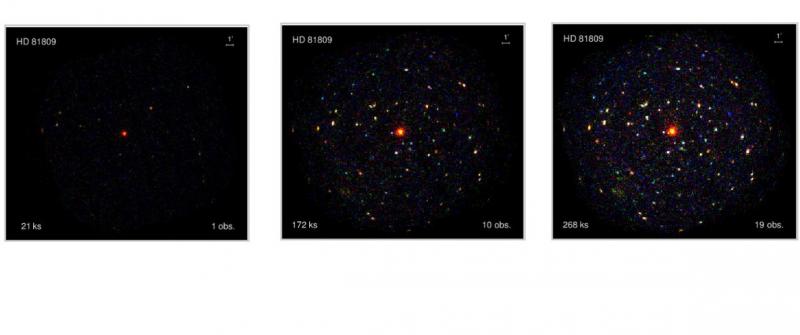Digging deeper: the first catalogue of X-ray sources in overlapping observations published
The XMM-Newton Survey Science Centre (SSC) has published the first catalogue of X-ray sources from regions of the sky observed repeatedly. The catalogue comprises almost 72,000 objects, partly of exotic nature, which were observed with the space-based X-ray telescope XMM-Newton. The catalogue provides information on the physical properties of the sources and enables astronomers to identify brightness variations on time scales of years – and includes several thousand newly discovered X-ray sources.
Since its launch at the end of 1999, the European Space Agency’s X-ray observatory XMM-Newton has studied many patches of the sky repeatedly. The SSC has developed new software to search for astrophysical objects in overlapping data and used it to compile the first catalogue of sources from these deep observations. “By combining multiple pointings, greater accuracy is reached and fainter sources can be found that are not detectable in the individual observations”, explains Natalie Webb (IRAP), director of the SSC.
The new catalogue comprises 71,951 X-ray sources in 1,789 XMM-Newton observation. The catalogue can be used to trace brightness changes of X-ray sources over time scales of up to 14.5 years. Scientists all over the world have been using the XMM-Newton Source Catalogues to get new information on their areas of research and to search for rare or new X-ray emitting objects.

X-ray telescopes: the invisible made visible
X-ray observations open a window to regions of the Universe that are invisible to the human eye. X-rays arise from extremely energetic processes, for example from hot gas at temperatures of hundreds of millions degrees. Objects emitting X-rays range from hot or very compact, collapsed stars to massive black holes in distant galaxies and to galaxy clusters billions of light years away from the Earth.
The XMM-Newton Survey Science Centre Consortium was established more than twenty years ago. It is a team of scientists in several European countries, including France, Spain, the United Kingdom and Germany. They process the publicly available XMM-Newton observations and publish catalogues of all serendipitously detected X-ray sources.
For further information:
- http://xmm-ssc.irap.omp.eu/fr/accueil/
- http://xmmssc.irap.omp.eu/Catalogue/3XMM-DR7s/3XMM_DR7stack.html
IRAP Contact
- Natalie Webb, Natalie.Webb@irap.omp.eu






